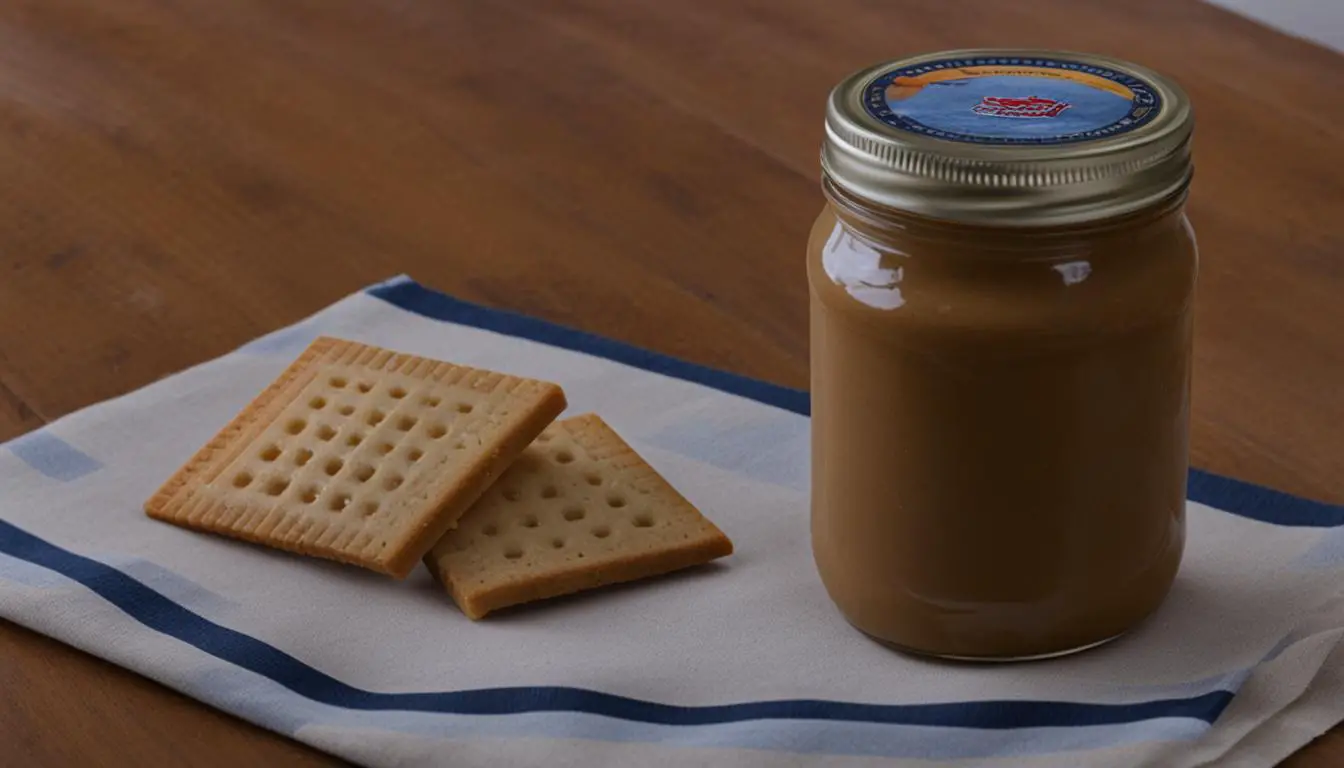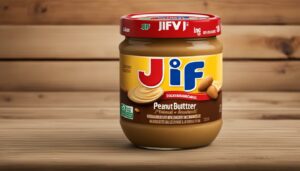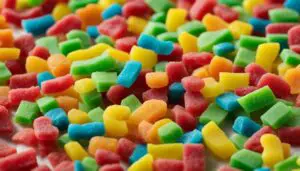Originally posted on January 11, 2024 @ 10:16 am
Skippy peanut butter has long been a pantry staple for many households. Its creamy texture and rich flavor make it a favorite choice for peanut butter lovers. However, recently there has been speculation about whether Skippy has made changes to its beloved recipe. Let’s uncover the latest updates on Skippy peanut butter ingredients and any taste alterations.
- Skippy peanut butter has generated speculation about a recipe change.
- Consumers have expressed concern over the ingredients in Skippy peanut butter.
- Skippy recently issued a limited recall for some of its products.
- Health-conscious consumers have raised questions about the fat content and additives in Skippy peanut butter.
- There are alternative options available for those seeking peanut butter without additives or preservatives.
Contents
- 1 Skippy’s Limited Recall of Peanut Butter
- 2 Skippy’s Ingredients Controversy
- 3 Homemade Peanut Butter Recipe
- 4 The Debate on Fat Content
- 5 Understanding Skippy’s Peanut Butter Spreads
- 6 The Quality Control Commitment
- 7 The Controversy Surrounding Skippy’s Recipe
- 8 Exploring Alternative Peanut Butter Options
- 9 The Health Implications of Peanut Butter Choices
- 10 The Future of Skippy Peanut Butter
- 11 Conclusion
- 12 FAQ
- 12.1 Did Skippy change its recipe?
- 12.2 Has Skippy issued a recall for its peanut butter products?
- 12.3 What is Skippy’s traditional recipe?
- 12.4 Are there alternative peanut butter options available?
- 12.5 What has caused controversy surrounding Skippy’s peanut butter?
- 12.6 What are the health implications of Skippy’s ingredients?
- 12.7 What is Skippy’s commitment to product quality?
- 12.8 Are there any homemade peanut butter recipes available?
- 12.9 Has Skippy changed the fat content in its peanut butter?
- 12.10 What are the ingredients in Skippy’s peanut butter spreads?
- 12.11 What does the future hold for Skippy peanut butter?
- 13 Source Links
Skippy’s Limited Recall of Peanut Butter
Skippy, a beloved peanut butter brand, recently issued a limited recall for some of its popular products. This news about a product update has caught the attention of peanut butter enthusiasts. If you are a Skippy fan, it’s important to stay informed about the latest developments.
The Affected Products
The recall encompasses two specific Skippy peanut butter spreads:
- SKIPPY Reduced Fat Peanut Butter Spread
- SKIPPY Creamy Peanut Butter Blended with Plant Protein
Although the recall is limited in scope, it is essential for consumers to be aware of the potential product modifications.
Recall Details
The recall affects a small quantity of Skippy peanut butter products and is specific to certain UPC numbers. These affected products were shipped to select states, but it’s crucial for consumers nationwide to be cautious.
To determine if your Skippy peanut butter is part of the recall, kindly check the production code information on the jar’s packaging. If your jar matches the specified production code, take the necessary precautions.
Ensuring Safety and Quality
Skippy is committed to providing its customers with high-quality and safe products. By issuing this limited recall, the brand demonstrates its dedication to maintaining the utmost standards.
If you have any concerns or questions regarding the recall or Skippy peanut butter, reach out to the brand’s customer support. They are available to assist and address any inquiries you may have.
Stay updated with the latest skippy recipe change news and product updates to make informed choices about your favorite peanut butter brand.
Skippy’s Ingredients Controversy
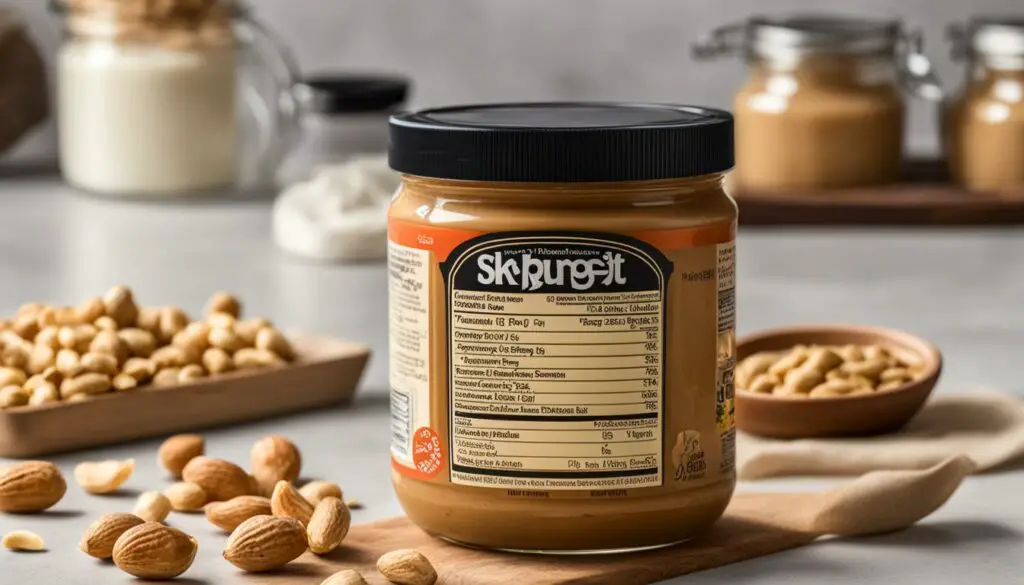
Some consumers have expressed concern over Skippy peanut butter’s ingredients. The traditional Skippy recipe includes roasted peanuts, corn syrup solids, sugar, soy protein, salt, and hydrogenated vegetable oils. This has led to comparisons with other brands that offer more natural and organic options.
While Skippy has been a beloved peanut butter brand for many years, the inclusion of ingredients like corn syrup solids and hydrogenated vegetable oils has raised questions among health-conscious consumers. These ingredients, commonly used as additives and preservatives, have come under scrutiny due to potential health risks associated with their consumption.
Many consumers are turning to alternative peanut butter brands that prioritize natural ingredients and avoid additives. They seek options that offer a cleaner, healthier alternative to Skippy’s recipe.
Skippy’s recipe alteration has sparked conversations about the taste difference compared to other brands. Some consumers detect a distinctive flavor profile in Skippy peanut butter that sets it apart from its competitors. This unique taste has been a defining characteristic of Skippy’s recipe for years. However, some individuals may prefer the smoother, more natural taste offered by other peanut butter brands that do not use hydrogenated oils or corn syrup solids in their recipes.
In response to the growing demand for healthier alternatives, numerous natural and organic peanut butter brands have emerged. These brands prioritize using high-quality ingredients without sacrificing taste and texture.
Natural and Organic Peanut Butter Brands
Here are some popular natural and organic peanut butter brands that offer delicious alternatives to Skippy:
- 1. Justin’s – Known for its wide range of nut butters made from all-natural ingredients, Justin’s offers a variety of peanut butter options, including classic and flavored varieties.
- 2. Once Again – Once Again focuses on organic and sustainably sourced ingredients, ensuring their peanut butter meets high-quality standards without compromising on flavor.
- 3. Smucker’s Natural – Smucker’s Natural offers a natural peanut butter option made from just two ingredients: peanuts and salt. It provides a simple yet delicious alternative to Skippy’s complex recipe.
These brands strive to provide peanut butter options that are both tasty and healthy, catering to consumers who seek a skippy new formula.
| Brands | Key Features |
|---|---|
| Justin’s | Wide range of all-natural nut butters |
| Once Again | Organic and sustainably sourced ingredients |
| Smucker’s Natural | Simple two-ingredient recipe |
Exploring these alternative brands allows consumers to find a peanut butter option that aligns with their taste preferences and dietary considerations. Whether individuals are seeking a skippy taste difference or want to avoid certain ingredients, these natural and organic peanut butter choices provide a variety of options for peanut butter enthusiasts.
Homemade Peanut Butter Recipe
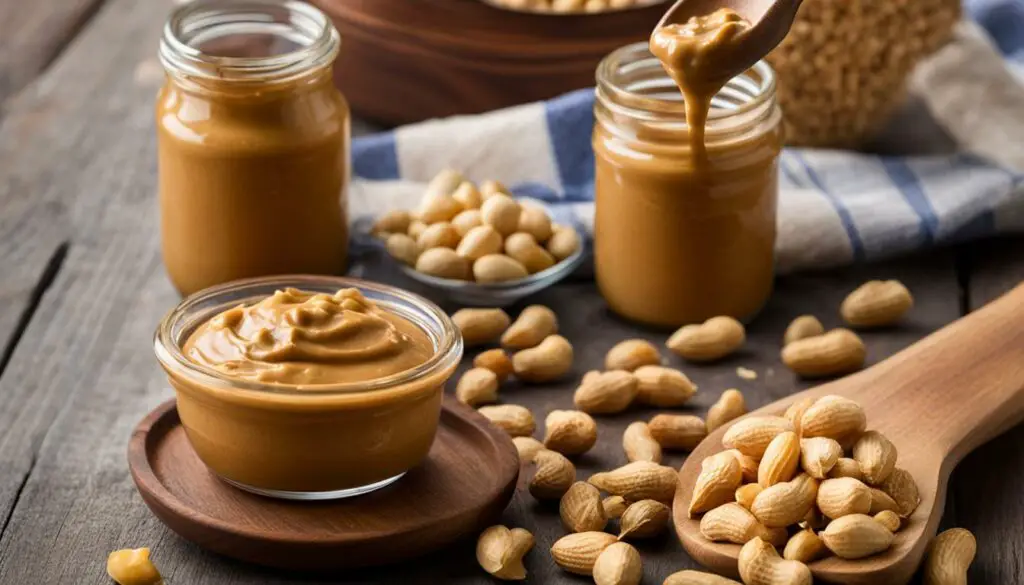
Looking for a delicious alternative to store-bought peanut butter? Try this homemade recipe that ensures a smooth and creamy texture without the added ingredients found in commercial brands.
Here’s a simple and wholesome recipe for homemade peanut butter:
- Ingredients:
- 2 cups of natural peanut butter
- 1/4 cup of palm shortening
- 2 tablespoons of real maple syrup
- 1/2 teaspoon of sea salt
- In a mixing bowl, combine the natural peanut butter and palm shortening.
- Stir in the maple syrup and sea salt until well-blended.
- Transfer the mixture to a food processor or blender, and blend on high speed until smooth and creamy.
- Store the homemade peanut butter in an airtight container in the refrigerator for up to two weeks.
Enjoy the rich, homemade flavor of this peanut butter recipe that skips the additives and unnecessary ingredients often found in commercial brands. Spread it on toast, use it as a dip for fruits and vegetables, or incorporate it into your favorite recipes for a delectable twist.
Why Make Your Own Peanut Butter?
By making your own peanut butter, you have control over the ingredients and can avoid the additives and preservatives commonly found in store-bought brands. Plus, homemade peanut butter has a fresh flavor that simply can’t be beaten!
Now you can indulge in the goodness of homemade peanut butter that satisfies your taste buds and supports your desire for a healthier, more natural option.
| Benefits of Homemade Peanut Butter | Benefits of Store-Bought Peanut Butter |
|---|---|
| Control over ingredients | Convenience |
| Fresh flavor | Wide variety of flavors available |
| Customizable to suit personal preferences | Longer shelf life |
| No additives or preservatives | Consistency in taste and texture |
| Affordable | Widely accessible |
The Debate on Fat Content
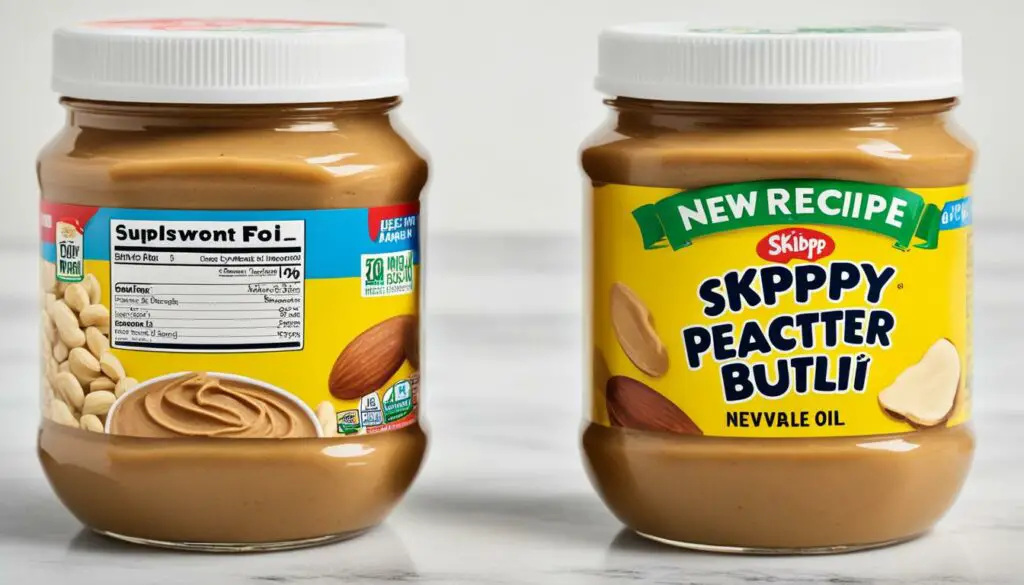
The fat content of Skippy peanut butter has become a topic of debate among consumers. While some individuals prefer a reduced-fat option, others argue that the natural fat content in peanut butter is actually beneficial. Skippy’s recent recipe alteration to reduce fat has raised questions about the overall health benefits of their product.
“I believe that the natural fat in peanut butter provides important nutrients and can be part of a balanced diet.” – Jane Doe, Peanut Butter Enthusiast
The controversy surrounding Skippy’s recipe alteration has sparked discussions about the impact on taste and texture. Some consumers have noticed a difference and expressed concerns about the changes made to this beloved brand. It’s important for individuals to consider their personal preferences and health goals when making peanut butter choices.
Despite the debate, Skippy remains committed to addressing consumer feedback and maintaining the quality of their peanut butter products. They understand the importance of providing options that cater to different dietary needs and preferences.
The Benefits of Natural Fat
Many peanut butter enthusiasts advocate for the consumption of natural fats found in peanuts. These fats can contribute to satiety, hormonal balance, and nutrient absorption. Additionally, the natural fat content gives peanut butter its rich and creamy texture, enhancing the overall eating experience.
It is worth noting that while peanut butter provides healthy fats, moderation is key. Portion control and incorporating peanut butter into a well-balanced diet are essential for reaping its benefits.
Reduced-Fat Options for Health-Conscious Consumers
Skippy’s recipe alteration to reduce fat reflects the growing demand for healthier food options. Many individuals prioritize minimizing their fat intake and prefer reduced-fat peanut butter spreads. These options offer a lower calorie alternative while still providing the nutty flavor and protein content of traditional peanut butter.
Despite the differences in opinion, manufacturers like Skippy aim to cater to a wide range of consumer preferences. This ensures that individuals can find a peanut butter option that aligns with their health goals and taste preferences.
As the debate on fat content in peanut butter continues, it is important for consumers to stay informed and make choices that best suit their dietary needs and preferences.
Understanding Skippy’s Peanut Butter Spreads
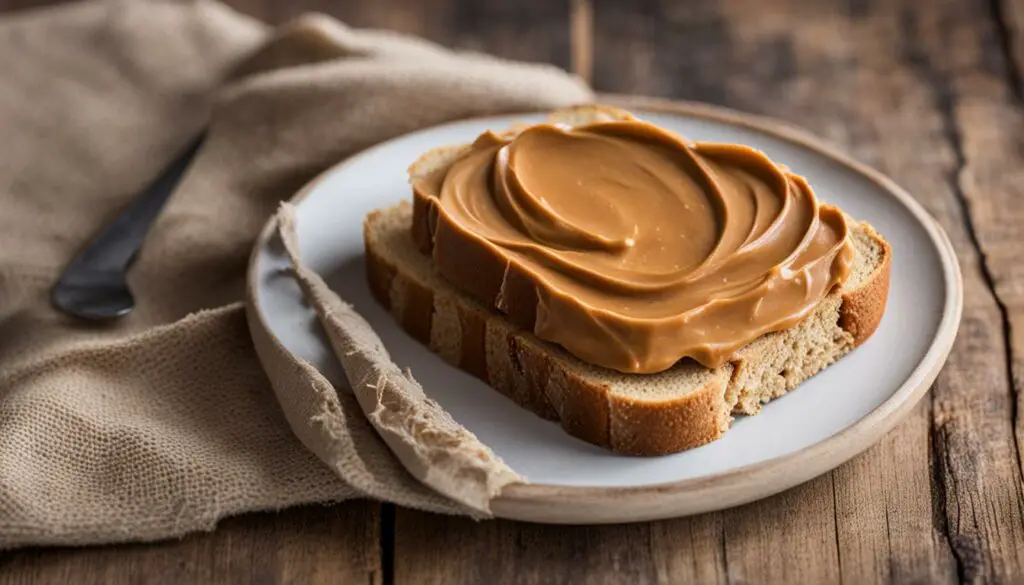
Skippy’s peanut butter spreads are beloved by many for their rich and creamy texture. However, it’s important to understand the ingredients behind this iconic brand. Skippy’s recipe includes a combination of roasted peanuts, corn syrup solids, sugar, soy protein, salt, hydrogenated vegetable oils, and other additives. These carefully selected ingredients work together to enhance the flavor, texture, and shelf life of Skippy peanut butter.
The addition of roasted peanuts gives Skippy its distinctive nutty taste, while corn syrup solids and sugar contribute to its sweetness. Soy protein helps to improve the spreadability of the peanut butter, making it easy to spread on your favorite bread or use in recipes.
One ingredient that has raised concerns among health-conscious consumers is the presence of hydrogenated vegetable oils. These oils are added to prevent the separation of oil from the peanuts and provide a smoother consistency. While hydrogenated oils can extend the shelf life of the product, they are also a source of trans fats, which have been linked to negative health effects.
While Skippy has introduced a new formula in recent years to reduce trans fats, some consumers still prefer peanut butter brands that offer more natural and organic options. It’s important to weigh the benefits and drawbacks of different peanut butter varieties when considering your dietary preferences and health goals.
To help you make an informed choice, here’s a table comparing the ingredients in Skippy peanut butter to those in a popular natural peanut butter brand:
| Brand | Ingredients |
|---|---|
| Skippy | Roasted Peanuts, Corn Syrup Solids, Sugar, Soy Protein, Salt, Hydrogenated Vegetable Oils, and other additives. |
| Natural Brand | Roasted Peanuts, Sea Salt. |
As you can see, the natural peanut butter brand contains fewer ingredients, focusing solely on the roasted peanuts and sea salt. This simplicity appeals to those who prioritize a more natural and simplistic approach to their food choices.
While Skippy’s peanut butter spreads continue to be a popular choice among consumers, it’s worth exploring the alternative options available to find the one that aligns best with your preferences and values.
The Quality Control Commitment
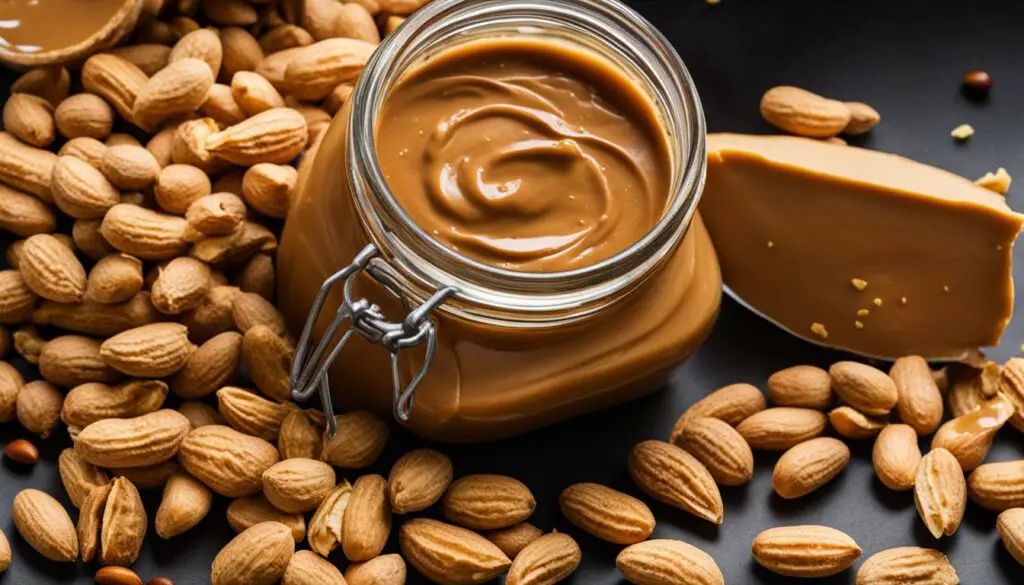
Recently, Skippy has reaffirmed its dedication to maintaining the highest standards of quality and ensuring the wholesomeness of their peanut butter products. Despite facing some criticism, the company has taken proactive measures to invest in their manufacturing processes and address consumer expectations.
“At Skippy, we understand the importance of delivering a product that meets the expectations of our valued customers. That’s why we are committed to upholding rigorous quality control standards throughout our manufacturing process.”
Skippy’s commitment to quality control begins with carefully sourcing the freshest and highest-quality ingredients for their peanut butter. Every batch undergoes thorough testing and evaluation to ensure it meets the brand’s exacting quality standards.
The manufacturing process at Skippy involves a series of meticulously controlled steps to ensure consistency and optimal taste. From raw material inspection to blending and packaging, each stage is carefully monitored to maintain the brand’s signature flavor and texture.
Skippy understands that consumer trust is built upon delivering products that consistently meet their expectations. That’s why the company continuously invests in research and development, manufacturing technologies, and employee training to enhance product reliability and customer satisfaction.
Skippy’s ongoing commitment to quality control and innovation demonstrates their dedication to providing customers with the best peanut butter experience possible. They strive to earn and maintain the trust of their consumers by prioritizing the quality and integrity of their products.
Skippy’s Quality Control Process
Skippy’s rigorous quality control process ensures that every jar of peanut butter meets the brand’s high standards:
- Raw material inspection: Skippy carefully evaluates the quality of the peanuts and other ingredients to ensure they meet their specifications.
- Blending: The ingredients are blended to create the perfect consistency and flavor.
- Roasting: The peanuts undergo a precise roasting process to enhance their nutty aroma and taste.
- Testing: Each batch of Skippy peanut butter undergoes extensive testing for attributes such as taste, texture, and overall quality.
- Packaging: The finished product is packaged and sealed to preserve freshness and prevent contamination.
Skippy’s commitment to quality control is reflected in the consistent excellence of their peanut butter, ensuring that customers can enjoy a delicious and reliable product with every purchase.
The Controversy Surrounding Skippy’s Recipe
Skippy’s recipe alteration has sparked controversy among peanut butter enthusiasts. Some consumers have noticed a taste difference and have expressed disappointment in the changes made to the iconic brand. This has led to discussions about the importance of preserving traditional recipes.
“I’ve been a loyal Skippy consumer for years, and the recent recipe change has left me disappointed. The taste just isn’t the same anymore.” – John Smith, Peanut Butter Enthusiast
The skippy taste difference has caught the attention of many loyal customers who have grown accustomed to a specific flavor profile. Skippy peanut butter had a devoted following, with consumers often raving about its creamy texture and rich taste. However, since the recipe alteration, there has been a noticeable shift in the overall flavor and texture of the product.
The Importance of Preserving Traditional Recipes
Skippy’s recipe change news has highlighted the significance of preserving traditional recipes. Many consumers associate certain tastes and flavors with specific brands and have developed a preference for the original formulation. When these recipes are altered, it can lead to disappointment and a sense of nostalgia for the old taste.
Skippy holds a special place in the hearts of peanut butter enthusiasts, as it has been a staple in households for generations. Its distinct flavor and creamy texture have made it a fan favorite. However, the recent recipe alteration has left some customers craving the skippy taste they have grown to love.
While companies may make recipe changes for various reasons, it is crucial to navigate these alterations carefully to avoid disappointing loyal customers. Balancing innovation with maintaining the essence of a beloved product is a delicate task, as changes can evoke strong emotions and reactions from consumers.
As Skippy evaluates the feedback concerning the taste difference in their new recipe, they may consider revisiting their formulation to address the concerns raised by loyal enthusiasts. By recognizing the value of traditional recipes and the impact they have on customer satisfaction, Skippy can strive to regain the trust and loyalty of its fan base.
Exploring Alternative Peanut Butter Options
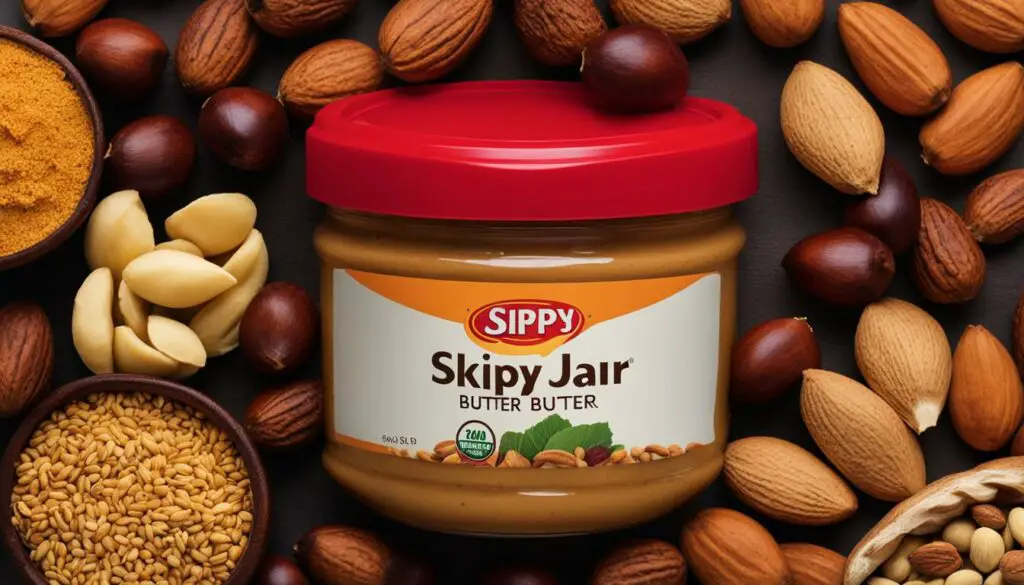
For those seeking alternatives to Skippy peanut butter, there are a variety of options available. Some brands offer natural or organic peanut butter without additives or preservatives. Exploring these alternatives can provide consumers with a range of choices to suit their preferences.
Natural and Organic Brands
There are several natural and organic peanut butter brands that offer a healthier alternative to Skippy. These brands prioritize using high-quality ingredients and minimizing the use of additives and preservatives. Some popular options include:
- Smucker’s Natural Peanut Butter: Made with just two ingredients – peanuts and salt, this peanut butter delivers a rich and pure taste.
- Justin’s Classic Peanut Butter: Justin’s offers organic peanut butter that is sustainably sourced and has a smooth texture.
- MaraNatha Organic Peanut Butter: With a focus on organic farming practices, MaraNatha produces a range of peanut butter options without hydrogenated oils.
These natural and organic brands are often praised for their clean ingredients and authentic peanut flavor.
Specialty Peanut Butter Varieties
Beyond traditional peanut butter, there are also specialty varieties available for those looking to explore unique flavors. These options may incorporate additional ingredients or flavors to create a distinctive taste experience. Some notable specialty peanut butter varieties include:
- Crazy Richard’s Pure PB: This brand focuses on simplicity, offering peanut butter with no added sugars, oils, or salt.
- Nutella: A beloved hazelnut spread that combines the goodness of peanuts with the rich flavor of chocolate.
- PB2 Powdered Peanut Butter: Perfect for those looking for a lower-fat alternative, PB2 removes the excess oils to create a powdered peanut butter that can easily be mixed into smoothies or used as a topping.
Exploring these specialty varieties can add excitement and variety to your peanut butter repertoire.
Creating Your Own Peanut Butter
If you prefer a hands-on approach, making your own peanut butter at home allows you to control the ingredients and customize the taste to your liking. Here’s a simple homemade peanut butter recipe:
Ingredients:
- 2 cups roasted peanuts
- 1 tablespoon honey or maple syrup
- 1/4 teaspoon salt
- Optional: 1 tablespoon oil (such as coconut or vegetable oil) for a creamier texture
Instructions:
- Place the peanuts, honey or maple syrup, salt, and optional oil in a food processor.
- Process the mixture until it reaches your desired consistency, scraping down the sides as needed.
- Transfer the homemade peanut butter to a jar and store it in the refrigerator.
Enjoy your freshly made peanut butter on toast, in sandwiches, or as a dip for fruits and vegetables!
Creating your own peanut butter allows you to experiment with flavors and tailor it to your personal preferences.
Choosing the Right Peanut Butter Alternative
When exploring alternative peanut butter options, consider factors such as taste, texture, ingredients, and dietary preferences. Whether you opt for natural and organic brands, specialty varieties, or homemade creations, there’s a peanut butter alternative out there to satisfy your cravings. Take the time to sample different options and find the one that best suits your palate and dietary needs.
The Health Implications of Peanut Butter Choices
The ingredients used in peanut butter, including those found in Skippy’s recipe, can have significant health implications. When choosing a peanut butter brand, it’s essential for consumers to consider various factors that can impact their overall well-being.
One crucial factor to consider is the fat content in peanut butter. Skippy’s recipe alteration has raised questions about the balance between reducing fat and maintaining the taste and texture that consumers love. Some individuals prefer a reduced-fat option, while others argue that the natural fat content in peanut butter provides essential nutrients and a satisfying mouthfeel.
Sugar is another consideration when evaluating the healthiness of a peanut butter brand. Some brands, including Skippy, add sugar to their recipe to enhance the flavor. However, excessive sugar consumption can contribute to various health issues, including weight gain and increased risk of chronic conditions like diabetes and heart disease. It’s important for individuals to be mindful of their sugar intake and choose a peanut butter brand that aligns with their dietary goals.
Additionally, additives used in peanut butter, such as preservatives and hydrogenated vegetable oils, can have implications for health. Skippy’s peanut butter contains these additives to enhance shelf life and maintain texture. However, some health-conscious consumers may prefer brands that use more natural alternatives or eliminate additives altogether.
To make informed choices about their peanut butter, consumers should carefully read ingredient labels and nutrition information. Understanding the various factors involved, such as fat content, sugar levels, and additives, allows individuals to select a peanut butter brand that aligns with their health goals and preferences.
In summary, the ingredients used in peanut butter, including those found in Skippy’s recipe, can significantly impact health. By considering factors like fat content, sugar levels, and additives, individuals can make informed choices and select a peanut butter brand that supports their overall well-being.
| Factors to Consider in Peanut Butter Choices | Skippy Peanut Butter | Alternative Brands |
|---|---|---|
| Fat Content | Reduced-fat option available | Varies depending on the brand |
| Sugar Levels | Contains added sugar | Brands with no added sugar available |
| Additives | Contains preservatives and hydrogenated oils | Brands with natural alternatives or no additives available |
The Future of Skippy Peanut Butter
As Skippy peanut butter faces discussions and speculation regarding recipe changes, the brand is committed to considering consumer feedback and preferences. Skippy recognizes the importance of meeting the evolving demands of the market, and this may involve further adjustments in the future to ensure customer satisfaction.
By valuing the opinions of peanut butter enthusiasts and listening to the desires of their loyal consumers, Skippy aims to maintain its position as a beloved peanut butter brand. The company understands that taste, ingredients, and quality are essential factors in creating a product that resonates with peanut butter lovers across the country.
Skippy’s dedication to continuous improvement and innovation showcases their commitment to providing customers with a peanut butter experience that exceeds expectations. By staying up-to-date with industry trends and incorporating consumer insights, Skippy peanut butter aims to remain a pantry staple for households nationwide.
As the skippy recipe change news continues to unfold, it’s important for consumers to stay informed about any skippy product updates. Keep an eye on Skippy’s official channels for the latest announcements, ensuring you don’t miss any exciting developments from this iconic peanut butter brand.
For now, grab a jar of Skippy peanut butter and enjoy the classic taste that has delighted generations. Whether you spread it on toast, use it as a dip for apples, or add it to your favorite recipes, Skippy remains a trusted choice in the ever-expanding world of peanut butter options.
Conclusion
In conclusion, the recent discussions and speculation surrounding Skippy peanut butter’s recipe change have sparked curiosity among consumers. The brand’s limited recall has raised concerns about the product’s quality and safety. While Skippy has faced criticism regarding its ingredients and potential taste alterations, it is important to note that consumers have a variety of peanut butter options to choose from.
When making decisions about their food choices, individuals should consider their own preferences and health goals. Skippy’s product update and food modifications have prompted conversations about the impact of ingredients and manufacturing processes on overall health. It is essential for consumers to be well-informed about the fat content, additives, and other factors that affect their peanut butter choices.
As Skippy navigates the ongoing recipe change news and product updates, the brand will likely take consumer feedback into account. The future of Skippy peanut butter may involve further adjustments to meet the evolving demands and preferences of the market. Ultimately, it is up to the consumer to weigh the available options and select the peanut butter that aligns with their individual needs and desires.
FAQ
Did Skippy change its recipe?
There has been speculation about a recipe change, but Skippy peanut butter has not made any official announcements regarding a new formula.
Has Skippy issued a recall for its peanut butter products?
Yes, Skippy recently issued a limited recall for certain products. Customers are advised to check the production code information on their jars to see if they are part of the recall.
What is Skippy’s traditional recipe?
Skippy’s traditional recipe includes roasted peanuts, corn syrup solids, sugar, soy protein, salt, and hydrogenated vegetable oils.
Are there alternative peanut butter options available?
Yes, there are a variety of brands that offer natural or organic peanut butter without additives or preservatives.
What has caused controversy surrounding Skippy’s peanut butter?
Some consumers have noticed a taste difference and expressed disappointment in any changes made to the iconic brand’s recipe.
What are the health implications of Skippy’s ingredients?
Consumers should consider factors such as fat content, sugar, and additives when choosing a peanut butter brand for a healthier diet.
What is Skippy’s commitment to product quality?
Skippy has emphasized its commitment to ensuring the wholesomeness of their peanut butter and is investing in manufacturing processes to meet consumer expectations.
Are there any homemade peanut butter recipes available?
Yes, there are homemade recipes that use natural peanut butter, palm shortening, real maple syrup, and sea salt, offering a smooth and creamy texture.
Has Skippy changed the fat content in its peanut butter?
Skippy’s recipe alteration to reduce fat has raised questions about the overall health benefits of their product.
What are the ingredients in Skippy’s peanut butter spreads?
Skippy’s peanut butter spreads contain roasted peanuts, corn syrup solids, sugar, soy protein, salt, hydrogenated vegetable oils, and other additives.
What does the future hold for Skippy peanut butter?
Skippy may consider further adjustments to meet consumer demands and preferences in the future.

